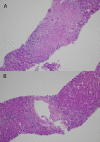Hepatic sarcoidosis resembling primary sclerosing cholangitis
- PMID: 34493554
- PMCID: PMC8424844
- DOI: 10.1136/bcr-2021-243492
Hepatic sarcoidosis resembling primary sclerosing cholangitis
Abstract
We report the case of a 29-year-old man who presented with progressive weight loss, night sweats, abdominal pain and pruritus who was found to have obstructive jaundice and cholestatic pattern of liver injury on laboratory workup. Though findings on magnetic resonance cholangiopancreatography were initially concerning primary sclerosing cholangitis, he was ultimately diagnosed with biliary sarcoidosis after a liver biopsy. This case brings attention to the rare phenomenon of hepatic sarcoidosis causing hyperbilirubinemia and highlights the importance of reaching the correct diagnosis early, as the patient's symptoms improved after initiation of steroids.
Keywords: gastrointestinal system; liver disease; pancreas and biliary tract.
© BMJ Publishing Group Limited 2021. Re-use permitted under CC BY-NC. No commercial re-use. See rights and permissions. Published by BMJ.
Conflict of interest statement
Competing interests: None declared.
Figures


Similar articles
-
Diffuse intrahepatic biliary strictures in sarcoidosis resembling sclerosing cholangitis. Case report and review of the literature.Dig Dis Sci. 1997 Jun;42(6):1295-301. doi: 10.1023/a:1018874612166. Dig Dis Sci. 1997. PMID: 9201098 Review.
-
Autoimmune hepatitis/primary sclerosing cholangitis overlap syndrome in a child: diagnostic usefulness of magnetic resonance cholangiopancreatography.J Paediatr Child Health. 2005 Apr;41(4):225-7. doi: 10.1111/j.1440-1754.2005.00593.x. J Paediatr Child Health. 2005. PMID: 15813880
-
Primary sclerosing cholangitis associated with CREST (calcinosis, Raynaud phenomenon, oesophageal dysmotility, sclerodactyly and telangiectasia) in an elderly woman: a case report.J Med Case Rep. 2015 Nov 25;9:272. doi: 10.1186/s13256-015-0747-9. J Med Case Rep. 2015. PMID: 26607041 Free PMC article.
-
Secondary sclerosing cholangitis in patients with drug-induced liver injury.Dig Liver Dis. 2015 Jun;47(6):502-7. doi: 10.1016/j.dld.2015.03.002. Epub 2015 Mar 11. Dig Liver Dis. 2015. PMID: 25840876
-
Recognizing primary biliary cirrhosis and primary sclerosing cholangitis.Am Fam Physician. 1996 Jan;53(1):195-200. Am Fam Physician. 1996. PMID: 8546046 Review.
Cited by
-
The clinical management of hepatic sarcoidosis: A systematic review.JGH Open. 2024 Jun 20;8(6):e13076. doi: 10.1002/jgh3.13076. eCollection 2024 Jun. JGH Open. 2024. PMID: 38903487 Free PMC article. Review.
-
Secondary sclerosing cholangitis and IgG4-sclerosing cholangitis - A review of cholangiographic and ultrasound imaging.Endosc Ultrasound. 2023 Mar-Apr;12(2):181-199. doi: 10.4103/EUS-D-22-00208. Endosc Ultrasound. 2023. PMID: 36588352 Free PMC article. Review.
-
Cirrhosis due to hepatic sarcoidosis: A rare presentation.Clin Case Rep. 2024 Jun 5;12(6):e8999. doi: 10.1002/ccr3.8999. eCollection 2024 Jun. Clin Case Rep. 2024. PMID: 38845805 Free PMC article.
References
Publication types
MeSH terms
LinkOut - more resources
Full Text Sources
Medical
